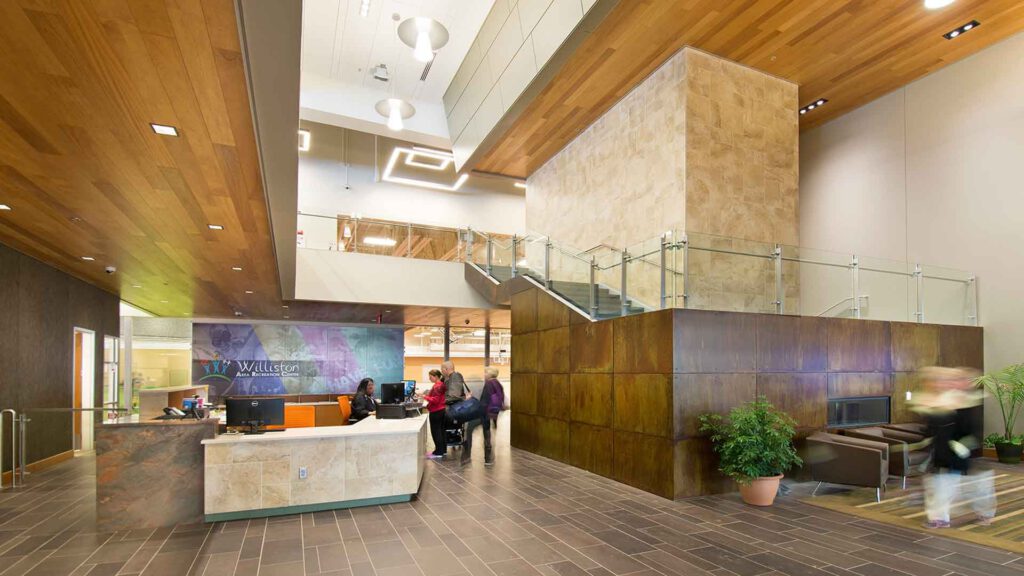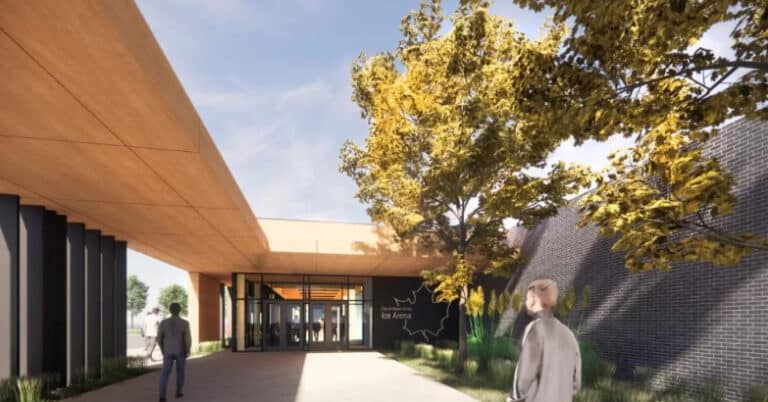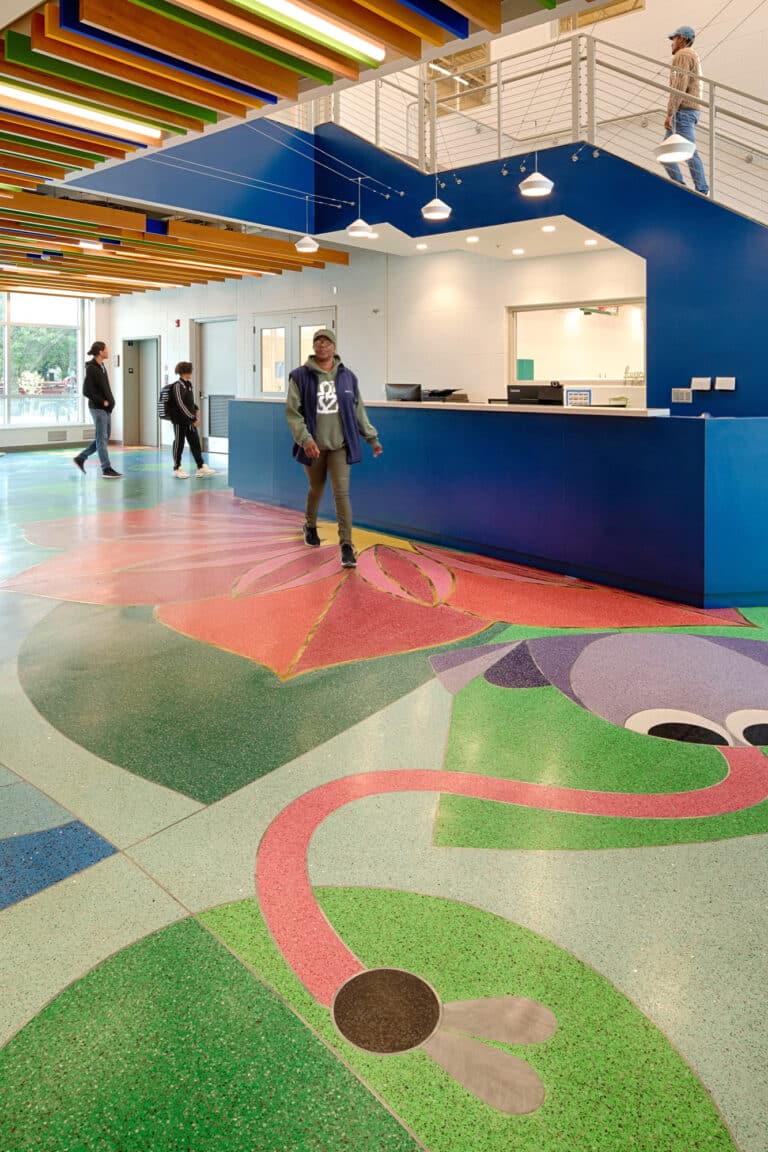What was once a quiet community in the rolling hills of Western North Dakota, Williston saw its population boom after striking oil in 2008, transforming from a town of 12,500 to a city of over 40,000 permanent and transient residents. This new influx of people brought with it challenges that turned into opportunities – from massive infrastructure and housing changes to hundreds of new school-age children looking to learn. Williston Parks & Recreation District saw an opportunity of its own: a chance to create an unparalleled recreational facility that would improve the quality of life and give all of Williston’s residents, new and old, a destination that would make them proud to live in this vibrant city. The end result was the Williston Area Recreation Center (2014) – the largest Parks & Recreation District -owned rec center in the United States, which has paid for itself in spades socially, healthily, and financially.
“When the oil boom hit, it confirmed what we already knew: we needed a place for our kids and the families that lived here and that would be moving here to relax, recreate, and enjoy a high quality of life,” said Darin Krueger, Executive Director of Williston Parks & Recreation District.
Overseen by Krueger, designed by lead architect JLG Architects and design architect Sink Combs Dethleffs Architects, and built by JE Dunn Construction, the success of the Williston Area Recreation Center, often called the ARC, shines through its details. From the earliest feasibility studies, community input drove the facility. For example, racquetball courts were not included in the original program, and so Williston local David Schmidt rallied a signed petition to add them – and they were incorporated soon after. “We actually lost the first vote without a recreation center in the proposal,” said Krueger. “We went back to the public to find out what they wanted and we answered with what they said – a rec center! We lost the first vote by 31 votes and won the second by over 800 votes.”
Williston State College was also part of the collaboration, offering to host the ARC on a 5-acre site on their campus and to the east of the city – saving site acquisition costs, allowing the WARC easy access to part-time student staffers, and assisting Williston State College in their own recruiting efforts and student amenity offerings. “We had great relationships with the City, Williston State College, Williston Public School District #1, Trinity Christian School, as well as all of our user groups. Together we all worked hard to bring the ARC to our community,” said Krueger. “The project was a team effort and without these entities, along with our Sale Tax Committee, it would have been an uphill battle. The Williston Community has always supported WPRD and our youth. This was no different.”
With the community’s assistance, the ARC was designed. The 236,000 sf multi-generational recreation facility would provide an aquatic center, full-sized tennis courts, four hardwood basketball/volleyball courts, and community meeting places. Natural light would fill the prominent aquatic center which would be complete with an indoor water park with slides, lazy river, zero-entry pool, and a surf-ready wave pool. A fully-accessible instructional pool with sunken benches to aid in swimming lessons and 53m Olympic size competition and diving pool with spectator seating would support the community’s athletics. The pool would feature tiles of pairs of fish native to North Dakota to tie into the “ARC” theme, and 35 million-95 million-year old regional fossils would be found around the aquatics park. Additionally, the main water park feature would be a water-filled “oil” derrick to pay homage to Williston’s growth. “The Flow Rider is our featured piece at the ARC,” said Krueger. “It was meant to hit the teenager group, but it has been incredibly popular with all ages, from 3-90 years old. Everyone loves it! JLG and JE Dunn handled the cost, and they were able to find areas of savings for us to add it into the budget.”
A 16,200 sf indoor turf field would create a space ideal for soccer, fastpitch and baseball practices, batting cages, pick-up volleyball games, and flexible space for kids to simply play. Adjacent to the Fieldhouse are 4 regulation tennis courts for youth/adult quickstart programs. A six-lane 200 meter running track would surround four hardwood basketball/volleyball courts open to the above fitness track to make up the extensive track and gym area. Recreational areas would include a golf simulator, a pitching simulator (which would later be adopted by the Los Angeles Dodgers), racquetball courts, spin room, group exercise classes, cardio area, and a two-story indoor playground. Youth gathering areas, senior social spaces and technology and flex spaces would function near a teaching kitchen and a child-sitting room would feature an animal mural coloring wall and is would incorporate a two-way mirror for parents to observe their children while exercising.
All in all, the ARC would allow Williston Parks & Recreation to add 28 new programs and average over 35 fitness classes a week. Infrastructure was also planned to limit costs when any future expansion is needed.
With community buy-in firmly in place, Williston Parks & Rec was able to pass a 1% sales tax in November 2011 to fund the $70 million facility. Half of the 1% went towards funding/bonds and the other half to District operations, while suspending the Parks & Rec’s property tax to the community. Two years after the ARC’s opening the community is still overwhelmed with the success of their funding efforts. “I believe the funding strategy of suspending property tax 100% in lieu of the sales tax has been a huge impact on our taxpayers,” said Krueger. “This has given them property tax relief of over $7,000,000 in 2012 to 2014”.
However, there was one major problem: the cost of construction was significant at this time, averaging 30-35% increase compared to other areas in the state due to the dramatic increase in building projects in Western North Dakota. This also meant that subcontractors were scarce, and so completing a project of this scale on a fast-track was difficult. Solutions for these drawbacks were settled by the onboarding of a Construction Manager early to provide value engineering and insight to keep the project on schedule and budget.
The collaboration with the Architect, Owner, and Construction Manager allowed the team to establish priorities and contingencies very early on to ensure that the project would meet the budget. As the project transformed, the group was informed to make decisions to maximize the dollars allotted for the project. Early involvement of the Construction Manager also provided an earlier construction start, with Footings and Foundations being started while the final design documents were being completed. In the end, the Williston Area Recreation Center was delivered slightly under budget and on schedule.
Upon opening, the Bismarck Tribune remarked, “The Williston Area Recreation Center is so enviable that if you don’t live in Williston, it could make you wish you did.” Today, the ARC is one of the major hot spots in Williston. Averaging 1,200 visitors a day, the ARC has already hosted its first triathlon, completely within the facility, and has earned a number of awards, including the 2014 Star Fund Project of the Year, 2014 NDRPA Golden Egg Award, and a 2014 American Institute of Architects North Dakota Merit Award. It has also been featured in Fortune Magazine, CNN Money, Athletic Business Magazine, and the Midco Sports Television.
The success of the facility has already allowed Williston Parks & Rec District to pay down $32.9 million in 44 months, paving way to possibly retiring the bond early. It has also helped Williston Parks & Rec do more around the community, completing $8.2 million in capital projects from Jan 1st 2012 to December 31, 2015 – including the renovation of 13 local parks.
It has also created a new, thriving industry – growing the Parks & Recreation District staff from 13 to more than 50. Previously having helped open a recreation center at The College at Brockport, a campus on the State University of New York, Ashley Krasicki – Recreation Manager, was able to apply her skillset to the ARC – this facility being more than double the size of her previous facility. “The features we have in this building are just unbelievable,” Krasicki said. Doug Richter, Williston native, searched tirelessly for a career his senior year at Minot State University. Upon graduation his best opportunity brought him home working as assistant facilities supervisor at the ARC. “These are career-type jobs,” Richter said.
The Williston Area Recreation Center worked collectively to inspire growth and celebrate the people of Williston. “Bringing a family to the rec center is like dropping your kids off at Disney,” said Larry Grondahl, a former member of the Park Board. “It’s a game-changer. It has really changed people’s outlook on moving here.”





